Fundraising Campaigns: The St George’s Fund
St George’s: A Voice for Change
The founders of St George’s School believed passionately that girls were as entitled to access to education as boys. Not a common view in the late 19th Century. Their determination led first to the opening of a teacher training college for girls in 1886, followed by the opening of St George’s High School for Girls in 1888. These trailblazing women’s courage and determination to provide a liberal education for girls resonates throughout the history of the school.
Throughout its pioneering history, St George’s has long relied upon the generosity of its supporters and believers to fulfil its aim to provide a well-rounded and forward-thinking education for girls.
The St George’s Fund




Fundraising through the years
The move to Ravelston
The early school proved so popular that it became clear that the buildings in Melville Street were not sufficient to accommodate the school’s needs. The founders reacted decisively with the commissioning of a new building in a ‘green and open area’ on the outskirts of Edinburgh. In 1914, the school moved from Melville Street to its current accommodation in leafy Ravelston, into a purpose-built building designed by the architect Balfour Paul; the current Upper School. Funds were raised by the wider school community through the purchase of debentures, to make this historic move possible. It is fascinating to see the sum of £7000 raised through debentures actually exceeded the estimated worth of the school’s assets which included three houses in Melville Street and one in Ravelston Park, valued in 1913 at around £5000!
Our archives contain this letter from the Headmistress at the time, Mary Walker, kindly requesting friends of the school to consider purchasing further debentures to enable this important development for the school. A large proportion of these debentures were not redeemed at the end of their agreed period but rather the money was gifted to the school. It is clear that without the generosity of donors and supporters, generations of young women would not have been able to benefit from the educational opportunities provided by St George’s, since 1914.
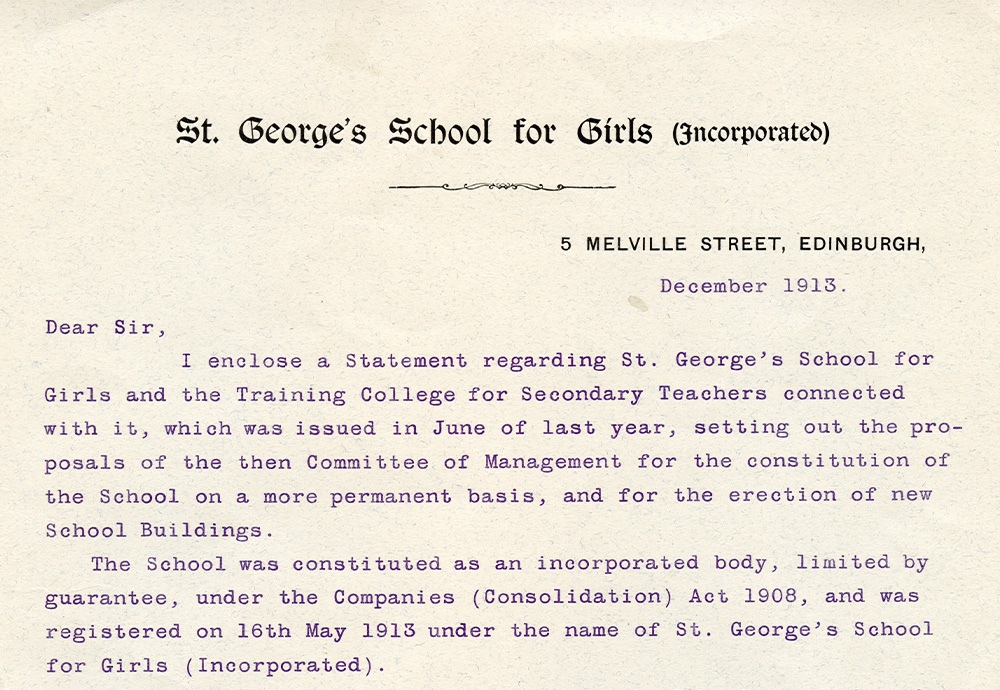
From those early days onward, St George’s has continued to engage with its supporters to attract their active contribution to school both physically and financially. Larger fund-raising projects have included:
The St George’s Fund
The Junior School
By 1962 the school had survived two world wars; evacuation to the Borders with a slump in numbers to 91 girls; ‘make do and mend’ in houses on Garscube Terrace until use of the school building could be regained from the army; and tough times during the late 1940s and 1950s while the country set about recovery after WW11.
Despite all of the above, by 1962, numbers had risen to 448, space was short and the Head, Jean Lindsay, announced plans for the school’s future:
“The Council has decided that the school must expand. This policy is unavoidable if St George’s is to remain true to the purpose for which the School was founded, that is to provide both a first-class academic education for girls wishing to go to University and a liberal education for girls who had no academic ambitions” Women of Independent Mind, by former member of staff Nigel Shepley.
A development plan proposing the building of a new preparatory department was announced.
Thanks to the foresight of earlier School Councils, land was plentiful. Cost of a new building was estimated to be £50,000 and so an appeal fund was established to raise £25,000. As this amount was soon achieved, the target was raised to £40,000.
An Appeal Committee was formed and a pamphlet produced, giving an outline of the proposed building, cost and the sum the Appeal Committee hoped to raise through donations. The initial pamphlet was followed a year later with a progress report. The forewords for both were written by then Chair of Council- Lord Migdale. The first pamphlet also provided reassurance that the school was in good shape to improve the main building but to their regret not to stretch to the cost of an additional building.

The Centenary Sports Hall
As school approached its Centenary Year in 1988, much consideration was given to the most appropriate way to commemorate this momentous occasion.
In the end, The School Council settled on an Indoor Sports Hall. As the cost of the building was to exceed £500,000 the school launched an appeal for funds.
The Architects Reiach and Hall were commissioned to submit a design for the building and in 1986, a pamphlet was produced showing details of the plan and inviting all those ‘who have any connection with or interest in St George’s School’ to contribute.
The Centenary Sports Hall was opened in August 1989 and a plaque just inside the door acknowledges the generous support of parents, Old Girls and many other Friends of the School.
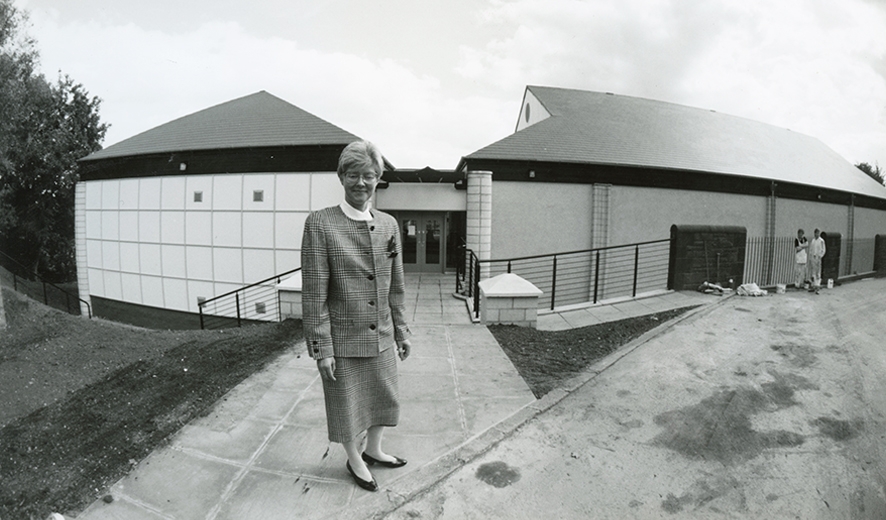
Jean Scott, Head outside Sports Hall
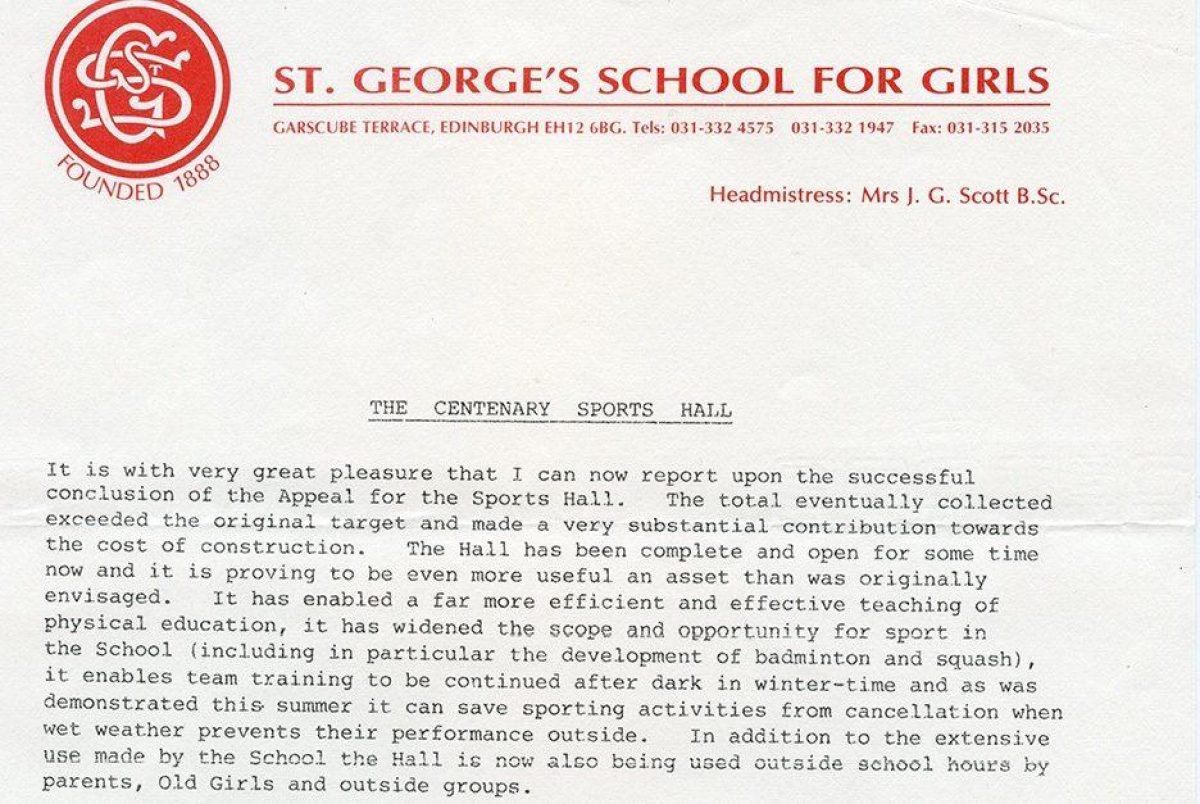
The Robertson Music Centre
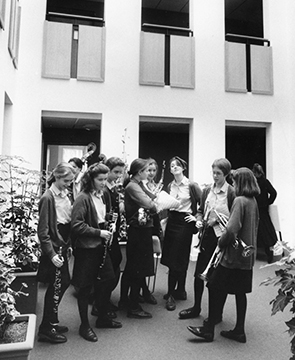
The Robertson Music Centre opened in 1991. This building is named in honour of the late Misses Robertson of Cawderstanes, all three of whom were former pupils of St George’s. The cost of building and equipping the building was largely met by the trust fund set up by the three sisters.
“With the objective of ensuring that the social talents of the St George’s pupils should be nurtured in purpose-built, aesthetically pleasing surroundings” The Scotsman 1991, by Wendy Travis.
The Director of Music at the time, David Coar, also recorded the school’s gratitude to parents and friends for their enthusiasm and hard work in raising money for the purchase of pianos, including a Bluthner grand piano.
Futures Fund
The formal opening of the St George’s Centre in 2001 saw the launch of ‘The Futures Fund’. The new dining centre was the first major building project in the school’s third millennium development programme and the School Council planned to make this an opportunity to launch further fund-raising activities.
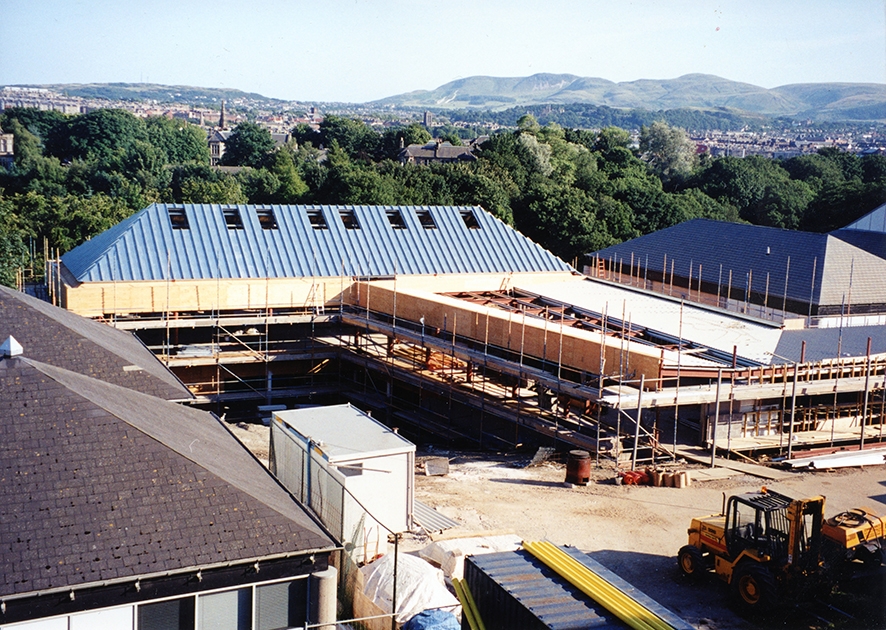
As the Futures Fund grew it was used to make contributions to the following school-funded projects:
2001 St George’s Centre
2002 Sixth Form reading room
2002 refurbishment of the sports pavilion (to include a dedicated space for Uniform Exchange)
2003 contribution to the transformation of previous kitchen and dining room areas into the Upper School Library
2004 formation of the Languages wing in the Upper School G1 corridor in an area that used to be locker rooms
2005 formation of Drama Studio in Lower Centre – curtains, lighting, lighting board, projector and screen
2006 Futures Room in Junior School equipped with screen and projector and first sound system
2006/7 Upper School refurbishment began with purchase of new chairs and stacking trolleys, bench seating in the balcony, new curtains and hall floor sanded
2009 M8 classroom set up as a Communications Hub and, in Middle School, one set of toilets refurbished as chosen by the students
2011 sound studio formed in RMC
2014 replacement of the sport pavilion with the addition of the tartan running track and long jump
The St George’s Fund
Generous benefactors
Miss Mary Walker, the first Headmistress, left a legacy, some of which was used to start the bursary fund.
Dora Cheyne, one of the first and youngest girls when St George’s opened in 1888, returned to support her school as a member of the governing body and then in 1938 as president of the school’s Old Girls’ Association. When she died, she left the school a sum of money (stated as £2,000 in the pamphlet, The Story of St George’s School 1888-1966) which was used in the 1940s to build a new pavilion on the Games Pitches. The plaque commemorating this gift was incorporated into the new Everest Pavilion.
Elizabeth Mitchell, St George's student 1891-1898, the first Scottish woman to gain a double first in Classics at Oxford. She went on to become the first lady town planner in Scotland and took an active part in the creation of East Kilbride and Cumbernauld. Miss Mitchell always appreciated the work of her old school. In 1917 she became Honorary Secretary of the School Council and retained that post for 34 years. On her death she left a legacy to school. This sum was added to the remaining legacy from Miss Walker to build ‘a Lodge’ for the Janitor.
Lord Salvesen, Chair of Council (1913 - 39) covered the cost to reharl and paint the outside of the building.
Dr Sheila McCallum, former pupil and Head of Chemistry at St George’s from 1962 until her premature death in 1975. On her death, her family made the school a bequest which was used to refit the Chemistry Lab in School and then gave a further bequest to fund additional IT, audio-visual and scientific facilities for the same lab – now called the McCallum Lab.
Mrs Grace Anderson (nee Biggart) from student 1921–27 left a bequest which was included in the fund-raised money used to transform the Upper School dining room and kitchen areas into the current library.
In 2002, Lord and Lady Clyde commissioned and paid for the planting of the garden area to the left of St George’s Centre entrance.
These examples represent only a few of our numerous generous supporters, each of whom has significantly impacted the lives of future generations of girls.



How to donate
Dedicated fund raising to a named programme has been in abeyance at St George’s for a few years but the ethos of St George’s has always been to look to the future with boldness and bravery, then to engage with supporters of school and all who believe in the power of education to seek their help to put these plans into action.
For those who have enjoyed and benefitted in any way from St George’s, the opportunity to give something back and make a difference to future generations of girls, is significant and powerful.
We welcome donations for the St George's Fund which go towards upgrading and improving the school facilities and campus. If you would like to donate to the school please click the button below.




